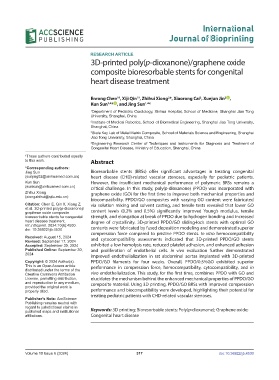Page 325 - IJB-10-6
P. 325
International
Journal of Bioprinting
RESEARCH ARTICLE
3D-printed poly(p-dioxanone)/graphene oxide
composite bioresorbable stents for congenital
heart disease treatment
Enrong Chen , Xiji Qin , Zhihui Xiong *, Xiaorong Cai , Xuejun Jin 2 id ,
1†
1†
2
3
Kun Sun * , and Jing Sun *
1,4
1,4 id
1 Department of Pediatric Cardiology, Xinhua Hospital, School of Medicine, Shanghai Jiao Tong
University, Shanghai, China
2 Institute of Medical Robotics, School of Biomedical Engineering, Shanghai Jiao Tong University,
Shanghai, China
3
State Key Lab of Metal Matrix Composite, School of Materials Science and Engineering, Shanghai
Jiao Tong University, Shanghai, China
4 Engineering Research Center of Techniques and Instruments for Diagnosis and Treatment of
Congenital Heart Disease, Ministry of Education, Shanghai, China
† These authors contributed equally
to this work. Abstract
*Corresponding authors:
Jing Sun Bioresorbable stents (BRSs) offer significant advantages in treating congenital
(sunjing02@xinhuamed.com.cn) heart disease (CHD)-related vascular stenoses, especially for pediatric patients.
Kun Sun However, the insufficient mechanical performance of polymeric BRSs remains a
(sunkun@xinhuamed.com.cn) critical challenge. In this study, poly(p-dioxanone) (PPDO) was incorporated with
Zhihui Xiong graphene oxide (GO) for the first time to improve both mechanical properties and
(xiongzhihui@sjtu.edu.cn)
biocompatibility. PPDO/GO composites with varying GO content were fabricated
Citation: Chen E, Qin X, Xiong Z, via solution mixing and solvent casting, and tensile tests revealed that lower GO
et al. 3D-printed poly(p-dioxanone)/
graphene oxide composite content levels (0.2% and 0.5%) significantly improved Young’s modulus, tensile
bioresorbable stents for congenital strength, and elongation at break of PPDO due to hydrogen bonding and increased
heart disease treatment. degree of crystallinity. 3D-printed PPDO/GO sliding-lock stents with optimal GO
Int J Bioprint. 2024;10(6):4530.
doi: 10.36922/ijb.4530 contents were fabricated by fused deposition modeling and demonstrated superior
compression force compared to pristine PPDO stents. In vitro hemocompatibility
Received: August 15, 2024 and cytocompatibility assessments indicated that 3D-printed PPDO/GO stents
Revised: September 17, 2024
Accepted: September 30, 2024 exhibited a low hemolysis rate, reduced platelet adhesion, and enhanced adhesion
Published Online: September 30, and proliferation of endothelial cells. In vivo evaluation further demonstrated
2024 improved endothelialization in rat abdominal aortas implanted with 3D-printed
Copyright: © 2024 Author(s). PPDO/GO filaments for four weeks. Overall, PPDO/0.5%GO exhibited superior
This is an Open Access article performance in compression force, hemocompatibility, cytocompatibility, and in
distributed under the terms of the
Creative Commons Attribution vivo endothelialization. This study, for the first time, combines PPDO with GO and
License, permitting distribution, elucidates the mechanism behind the enhanced mechanical properties of PPDO/GO
and reproduction in any medium, composite material. Using 3D printing, PPDO/GO BRSs with improved compression
provided the original work is
properly cited. performance and biocompatibility were developed, highlighting their potential for
treating pediatric patients with CHD-related vascular stenoses.
Publisher’s Note: AccScience
Publishing remains neutral with
regard to jurisdictional claims in
published maps and institutional Keywords: 3D printing; Bioresorbable stents; Poly(p-dioxanone); Graphene oxide;
affiliations. Congenital heart disease
Volume 10 Issue 6 (2024) 317 doi: 10.36922/ijb.4530

